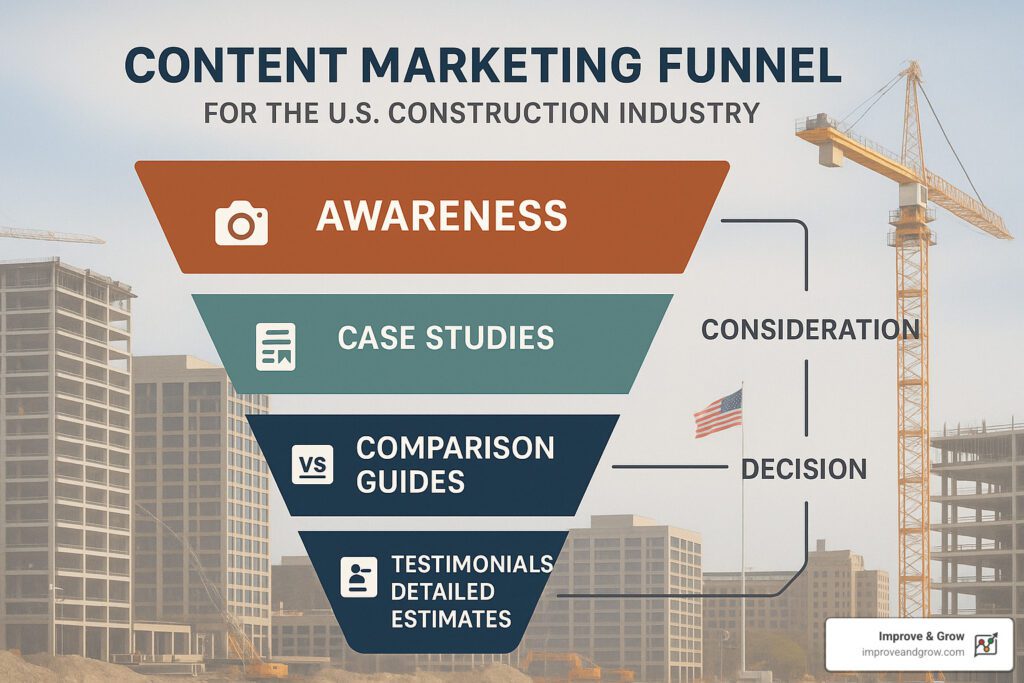Building Foundations for Digital Success in Construction
When it comes to the construction world, a hammer and nails alone won’t be enough to build a new structure. Content marketing for the construction industry requires as much precision and planning as your actual building projects. The good news? When done right, these strategies deliver impressive ROI for builders, contractors, and construction professionals.
Ready to break ground on your content strategy? Here’s your quick-start foundation:
| Content Marketing Quick-Start for Construction |
|---|
| 1. Define clear goals: Lead generation, brand awareness, or thought leadership |
| 2. Know your audience: Residential homeowners, commercial developers, or subcontractors |
| 3. Create visual-rich content: Project showcases, time-lapses, and before/after comparisons |
| 4. Optimize for local SEO: Target location-specific keywords and claim your Google Business Profile |
| 5. Distribute strategically: LinkedIn for B2B, Instagram for visual portfolios, Facebook for community engagement |
Construction companies face unique marketing challenges that other industries don’t. Your projects involve significant investments, lengthy decision-making processes, and high stakes for your clients. That’s why potential customers need more than just your sales pitch—they need concrete evidence of your expertise, reliability, and value.
“The construction industry has traditionally relied on word-of-mouth and referrals, but digital content marketing now provides an unprecedented opportunity to showcase expertise at scale,” says Carl Lefever, Founder & Digital Marketing Strategist at Improve & Grow. “Companies that effectively document their processes and results through strategic content are seeing significant competitive advantages.”
Unlike traditional advertising that disappears once you stop paying, content marketing builds lasting digital assets. Think of each blog post, project gallery, or video as a permanent showroom that continues attracting qualified leads 24/7. Research confirms that among marketing strategies for construction companies, content marketing consistently delivers one of the highest returns on investment by creating a sustainable pipeline of qualified prospects.
What makes construction content particularly powerful is its naturally visual nature. Your work creates dramatic changes that are perfect for today’s image-hungry platforms. The numbers back this up too—social media posts featuring images have been proven to perform better than plain text posts for construction companies, with Facebook posts with images receiving 2.3 times higher engagement than those without.
A thoughtfully executed content strategy transforms your hard-earned expertise into findable, shareable assets that attract prospects throughout their entire buying journey—from that first “renovation ideas” search to the final decision on which contractor to hire.

Basic Content marketing construction industry terms:
What You’ll Learn
In this guide, we’re not just skimming the surface—we’re digging deep into everything you need to know about content marketing for construction companies:
- How to set realistic content marketing goals that align perfectly with your construction business objectives (no pie-in-the-sky metrics here!)
- Practical methods for identifying your target audience’s pain points, questions, and decision factors (including what keeps them up at night about their building projects)
- The most effective content formats for showcasing your construction expertise and completed projects (hint: before-and-after changes are gold)
- SEO strategies specifically custom for construction companies that help you outrank your competitors for valuable local searches
- Proven tactics to amplify your content across digital channels, ensuring maximum visibility and lead generation without wasting your marketing budget
By the time you finish reading, you’ll have a blueprint for creating content that not only showcases your craftsmanship but also consistently brings new potential clients to your digital doorstep.
Why Content Marketing Matters for Construction Companies
The construction industry thrives on visual proof and trust. Before committing to a major project, potential clients want to see your previous work, understand how you operate, and feel confident in your abilities. Content marketing directly addresses these fundamental needs.
“Content marketing isn’t just about creating blog posts or social media updates. For construction companies, it’s about documenting excellence and building trust before the first meeting ever takes place,” explains Scott Rehnberg, SEO & Content Specialist at Improve & Grow. “It’s your digital portfolio, expertise showcase, and sales team all working together 24/7.”
When you showcase your completed projects through high-quality photos and videos, you’re not just displaying your work—you’re telling visual stories that resonate with potential clients. Research from HubSpot confirms this approach, finding that content with relevant images gets 94% more views than content without visuals.
The impact of strong content marketing construction industry strategies goes beyond aesthetics. When potential clients search for construction services in your area, quality content helps boost your visibility in search results. Educational content and detailed project showcases establish your credibility as an industry authority. Strategic content creates multiple entry points for prospects to find your business, generating leads even while you sleep. And once created, quality content continues working for you, making it one of the most cost-effective long-term marketing investments. In a crowded market, content that highlights your unique approach helps you stand out from competitors.
Content marketing construction industry: Business Benefits
The business benefits of content marketing extend far beyond simply attracting website traffic. When implemented thoughtfully, a content strategy delivers tangible returns:
Clients who find your business through content tend to be higher quality leads. Content that addresses specific pain points naturally attracts prospects with matching needs. A homeowner searching for “kitchen remodeling with limited space” who finds your detailed blog post on that exact topic is already pre-qualified.
Your sales cycles often become shorter and more efficient. Clients who have consumed your content before contacting you typically enter conversations further along in their decision process. They’ve already seen your work, understand your approach, and have begun to trust your expertise.
Well-crafted content marketing strategies lead to improved conversion rates. Your website begins generating more estimate requests, newsletter signups, and direct calls from prospects who feel informed and confident.
Perhaps most valuable of all, educational content helps build stronger client relationships. By providing valuable information without asking for anything in return, you position your company as a trusted advisor rather than just another service provider.
Consider this real-world example: AFT Construction’s blog post on kerf door jambs reached #1 on Google after just five months. That single piece of content now ranks for 227 keywords and saves them approximately $772 per month in potential ad spend—demonstrating how quality content can deliver continuous ROI for construction companies.
From Awareness to Contract
The construction buyer’s journey typically unfolds across three distinct phases, each requiring different content approaches:
During the Awareness Phase, potential clients are just beginning to recognize a need. They search for information like “How much does a kitchen renovation cost?” or “Signs you need to replace your roof.” At this stage, educational blog posts, infographics, and short videos that answer common questions without being overtly promotional work best. You’re building recognition by addressing pain points.
In the Consideration Phase, clients actively evaluate options and providers. They’re looking for comparisons between materials, detailed information about processes, and evidence of your expertise. Case studies, detailed guides, virtual tours of completed projects, and testimonials from similar clients help move prospects toward choosing you.
By the Decision Phase, prospects are ready to select a contractor. They need specific information about your services, clear next steps, and reassurance they’re making the right choice. Detailed service pages, FAQs about working with you, and client success stories with measurable outcomes all help convert interested prospects into clients.
“Understanding where your potential client is in their journey allows you to create content that meets them exactly where they are,” notes Jen Leong, Digital Marketing Strategist at Improve & Grow. “This targeted approach generates higher engagement and conversion rates than generic content.”
The beauty of content marketing for construction companies is that it addresses the entire customer journey. From the homeowner’s first Google search about renovation costs to the commercial developer comparing contractors for their next project, thoughtful content builds bridges between your expertise and their needs at every stage.
Blueprint: A Winning Content Marketing Construction Industry Strategy
Creating an effective content marketing strategy for your construction business requires careful planning and execution. Here’s how to build a framework that delivers results:

Set SMART Goals & Metrics
Every successful content marketing construction industry plan starts with clearly defined goals. Think of these goals as the foundation of your marketing house – without them, everything else may crumble.
For most construction companies, your objectives might include increasing website traffic from local prospects, climbing higher in search rankings for key terms like “commercial remodeling” or “custom home builder,” or generating a specific number of estimate requests each month.
The key is making your goals SMART – Specific, Measurable, Achievable, Relevant, and Time-bound. Rather than saying “get more leads,” try something like: “Increase website conversion rate from 2% to 5% within six months by creating targeted content for our three main service categories.”
“The average contractor website conversion rate is 5-10% when properly optimized,” says Brian Welch, Digital Marketing Strategist. “Setting realistic benchmarks based on industry standards helps you measure progress effectively.”
When tracking your progress, focus on meaningful metrics that tie directly to business outcomes. Website traffic is nice, but lead conversion rates tell you if that traffic is actually turning into potential projects. Similarly, track your search rankings, time visitors spend on your pages, and engagement rates across your distribution channels.
Map Topics to Search Intent
Understanding what your potential clients are searching for—and why—is like having a blueprint before breaking ground. It’s essential for creating content that both ranks well and converts visitors into leads.
Start by digging into keyword research using tools like Google Keyword Planner, Ahrefs, or SEMrush. Look for high-volume search terms related to your services, but don’t ignore those valuable long-tail keywords with less competition but higher intent. For construction companies, local search terms specific to your service areas are pure gold.
Once you have your keywords, map them to different types of search intent:
When someone searches “how to prepare for a home addition,” they’re seeking information, not necessarily ready to hire. But someone searching “get bathroom remodeling quote Philadelphia” is much closer to making a decision.
“Local SEO is particularly important for construction companies,” explains Scott Rehnberg. “Optimizing for ‘near me’ searches and location-specific terms can dramatically increase visibility to prospects in your service area.”
For each piece of content you create, optimize for on-site SEO by naturally incorporating your target keyword in the title, headings, and throughout the content. Don’t forget your meta descriptions, schema markup, and ensuring your site looks great on mobile devices.
Plan & Resource Your Calendar
A content calendar is your project management tool for marketing. It ensures you publish consistently and helps allocate resources effectively – just like you’d schedule subcontractors on a job site.
When planning your calendar, determine a publishing frequency that matches your resources – whether that’s weekly, bi-weekly, or monthly. Balance different content types across your sales funnel, and don’t forget to account for seasonality in construction services. For example, roofing content might perform better in spring and summer, while interior renovation content might see more interest during colder months.
“Consistency trumps frequency,” advises Carl Lefever. “It’s better to publish high-quality content monthly than to push out rushed content weekly. Your calendar should be ambitious but realistic given your resources.”
Resource-wise, be honest about what you can handle in-house versus what might need outsourcing. While you might have the expertise to write about construction topics, professional writers can often help shape that knowledge into content that ranks and converts. Similarly, budget for quality visual assets – professional photos of your projects will almost always outperform stock images.
Use this content calendar template to organize your content strategy and keep everything on track. And if you’re struggling with ideas, check out our guide on how to brainstorm content ideas to get those creative juices flowing.
Your content marketing construction industry strategy should be as carefully planned as any building project. With the right blueprint in place, you’ll create a sustainable system for attracting and converting the right clients for your construction business.
High-Impact Content Formats & Showcase Techniques
The construction industry is inherently visual, making it perfect for diverse content formats that show off your work and expertise. When potential clients can see your craftsmanship and understand your process, they’re much more likely to trust you with their projects.
Blogs That Rank & Educate
Blog posts serve as the foundation of many construction content strategies, addressing common questions while establishing your company as the go-to expert in your field.
Your construction blog can truly shine with topics that matter to your audience. Consider creating step-by-step guides for DIY projects (while subtly highlighting when professionals are needed), explanations of local building codes and permits, honest material comparisons, realistic project planning timelines, and practical maintenance tips for completed projects.
When crafting these posts, keep your writing conversational and accessible. Break up your content with scannable sections and descriptive headings that make it easy to digest. Naturally incorporate relevant local keywords, and always include high-quality images of your own projects – nothing builds credibility like showing your actual work. Finish with a clear call-to-action that guides readers toward becoming leads.
“Blog posts that address specific pain points or answer common questions not only rank well in search results but also establish your expertise,” notes Scott Rehnberg. “A single top-performing blog post can generate leads for years.”
More info about online content writing
Case Studies That Convert
Case studies work like magic for construction companies because they provide tangible evidence of your capabilities. Think of them as your portfolio with context and results attached.
The most compelling case studies follow a simple but powerful structure: Problem (the client’s challenge), Solution (your approach), and Results (measurable outcomes). This storytelling format resonates with potential clients who can see themselves in similar situations.
Make your case studies shine by including specific details that demonstrate real value – budget adherence, timeline improvements, obstacles you overcame, material choices with rationales, and of course, striking before and after visuals.
“Case studies don’t need to be lengthy—even a few paragraphs with compelling before and after images can be extremely effective,” says Jen Leong. “The key is quantifying results whenever possible, such as ‘completed 15% under budget’ or ‘finished three weeks ahead of schedule.'”

Video & Visual Storytelling
Video content creates immersive experiences that text alone simply cannot match. For construction companies, this visual medium offers incredible opportunities to showcase your work in motion.
Time-lapse videos showing project progression from start to finish compress months of work into minutes, creating a wow factor that’s hard to beat. Virtual tours of completed projects let prospects explore your craftsmanship in detail. Drone footage of larger developments provides impressive perspective, while behind-the-scenes glimpses of your team at work builds personal connection. Client testimonials on video add social proof with emotional impact, and how-to tutorials demonstrate your expertise in action.
“Video content typically generates higher engagement than other formats,” explains Brian Welch. “A 30-second time-lapse of a three-month project tells a compelling story that prospective clients can immediately understand and appreciate.”
To make your construction videos more effective, keep them concise – under two minutes for most formats. Add captions for accessibility and for viewers scrolling through social media with sound off. Maintain consistent branding throughout, and don’t forget to optimize titles and descriptions with relevant keywords. For maximum visibility, host your videos on YouTube and embed them on your website.
Repurpose & Maximize Value
Smart content marketing construction industry professionals know that repurposing stretches your investment and reaches audiences across different platforms. Think of it as getting multiple returns from a single investment.
That detailed blog post about sustainable building materials? Transform it into an eye-catching infographic or a social media carousel. Your 10-minute project walkthrough video can become five short clips highlighting different aspects of the build. Case studies work beautifully as downloadable PDFs that prospects can share with decision-makers. Even simple quotes and statistics from your content can become engaging social media posts.
“Content repurposing is like giving your content a fresh coat of paint—it saves you time and expands your reach,” says Scott Rehnberg. “A single project can generate dozens of content pieces across multiple channels.”
Pay special attention to creating evergreen content – information that remains relevant over time. Topics like material selection guides, maintenance tips, and regulatory compliance information continue attracting traffic and generating leads long after publication, providing ongoing value without requiring constant updates.
SEO, Social & Amplification Tactics for Builders
Creating stellar content is just the beginning of your journey. To truly generate ROI, your construction content needs strategic distribution that puts it in front of your ideal prospects.
Optimize Every Asset for Search
Every piece of content you create should work hard for you in search engines—this is where most of your future clients will start their journey.
Technical SEO forms the foundation of your visibility online. Start with the essentials: implement proper heading structure throughout your content, optimize your page loading speeds (particularly critical for mobile users), and create descriptive, keyword-rich URLs that tell both users and search engines what your page is about. Don’t forget to add alt text to all project images—this improves accessibility while giving search engines more context about your visual content.
For construction companies ready to take their SEO to the next level, consider these advanced tactics. Implementing schema markup specifically for local businesses and construction services helps search engines understand exactly what services you offer. Creating dedicated location pages for each service area dramatically improves your chances of appearing in local searches.
“Page speed isn’t just a technical consideration—it’s directly tied to your conversion rates,” notes Ricky Angeles, Systems Manager at Improve & Grow. “Our data shows that reducing load time from 8 seconds to 2 seconds can boost conversion rates by up to 74%, as prospects are often researching on mobile devices from potential project sites.”
Building citation listings on relevant directories and optimizing for “near me” searches with local keywords can significantly boost your visibility when potential clients are actively searching for services in your area.
Distribute Where Clients Scroll
Different social platforms serve unique purposes in your distribution strategy, and understanding where your specific audience spends their time is crucial.
LinkedIn is your go-to platform for B2B connections. This is where you’ll want to share industry insights and showcase your commercial projects. It’s the perfect space to engage with developers, architects, and commercial prospects while publishing thought leadership content from your company leaders.
Instagram’s visual nature makes it ideal for construction companies. Create visually striking posts showcasing your completed projects, use Stories to share behind-the-scenes content and work-in-progress updates, and leverage Reels for quick tips and dramatic project reveals that capture attention.
Facebook remains powerful for reaching homeowners—particularly with before-and-after changes that demonstrate your capabilities. It’s also excellent for building community through local event participation and using Groups to engage with local homeowners considering renovation projects.
“Social media posts with images get 2.3 times higher engagement on Facebook,” says Alex Mallin, PPC Specialist at Improve & Grow. “For construction companies, this visual advantage is crucial—always lead with your best project photos and videos.”
Beyond social media, consider additional amplification tactics like email newsletters featuring recent projects and educational content, guest posts on industry publications, local PR for noteworthy projects, and geotargeted social media advertising to reach specific neighborhoods where you want to build your presence.
Learn more about construction Industry Marketing Trends
Measure & Refine in Real Time
The true power of digital content marketing for the construction industry is the ability to measure performance and make data-driven improvements.
| Vanity Metrics | ROI Metrics |
|---|---|
| Page views | Conversion rate |
| Social followers | Cost per lead |
| Impressions | Lead-to-sale ratio |
| Likes/reactions | Customer lifetime value |
| Share counts | Return on ad spend |
“Focus on metrics that directly tie to revenue,” advises Carl Lefever, Founder & Digital Marketing Strategist at Improve & Grow. “While it’s nice to see high traffic numbers, what really matters is how many of those visitors become qualified leads and eventually customers.”
The right tools make measurement straightforward. Google Analytics provides comprehensive website performance data, while Google Search Console offers insights into your search visibility. Your CRM system tracks leads from first touch to closed deal, social media analytics platforms measure engagement, and call tracking software connects phone conversions back to their digital source.
Use these insights to continuously refine your approach: double down on content formats that generate the most qualified leads, expand on topics that perform well in search results, adjust your distribution channels based on engagement and conversion data, and test different calls-to-action to improve your conversion rates.
Content marketing is a marathon, not a sprint. The construction companies seeing the greatest success are those that consistently create valuable content, distribute it strategically, and refine their approach based on real performance data—not industry assumptions.
Frequently Asked Questions about Content Marketing Construction Industry
How long until results appear?
Content marketing isn’t a quick fix—it’s more like building a custom home than throwing up a pre-fab shed. You’ll see different results unfold over time as your strategy matures.
In the first 1-3 months, you’ll likely notice increased social media engagement as people interact with your fresh content. Your email open rates may climb as subscribers respond to valuable information, and you might receive initial feedback from existing clients who appreciate your expertise.
By months 3-6, the foundation starts to strengthen. You’ll see improved search rankings for your target keywords, increased website traffic as more people find your content, a growing email subscriber list, and those exciting initial leads starting to come through.
“It typically takes several months to start seeing concrete results from content marketing for contractors,” explains Scott Rehnberg. “However, once a page ranks highly in Google’s search results, it’s much easier to maintain that position long-term, creating a sustainable advantage.”
The real power emerges after 6+ months, when you’ll enjoy sustainable organic traffic growth, consistent lead generation, improved conversion rates, reduced cost per acquisition, and established brand authority in your market.
Several factors influence your timeline—the competitive landscape in your local market, the quality and consistency of your content, your existing website authority, and how aggressively you promote your content. Think of these as similar to construction variables that affect project timelines.
Which content works best—commercial or residential focus?
Just as you wouldn’t use the same materials for a hospital as a single-family home, your content should be custom to your specific audience.
For residential contractors, homeowner emotions and practical concerns should drive your content. Focus on common pain points (“How do I stop my basement from flooding?”) and aspirations (“Creating the dream kitchen”). Showcase specific rooms and home types relevant to your services.
Before-and-after content is particularly powerful in residential—homeowners love seeing changes. Balance emotional benefits (“Imagine entertaining in your new outdoor living space”) with practical ones (“Energy-efficient windows can reduce heating costs by 25%”). Distribution works best on platforms where homeowners spend time: Facebook, Instagram, and Pinterest.
Commercial contractors need a different approach. Highlight your expertise in specific building types or industries. Focus on ROI, timeline, and business impact rather than emotional benefits. Create detailed case studies with measurable outcomes like “Completed 20,000 sq ft office renovation with zero business interruption” or “Delivered medical facility 15% under budget.”
“The key is audience segmentation,” says Jen Leong. “Even if you serve both markets, create separate content streams that address the distinct needs and decision factors of each audience. A one-size-fits-all approach rarely performs well.”
If your construction company serves both markets, consider creating separate website sections for each audience with distinct content calendars and targeted distribution channels for each segment. This approach respects the different decision-making processes commercial and residential clients follow.
How do we track true ROI from content?
In construction, you wouldn’t start a project without plans and measurements—and the same applies to tracking your content marketing ROI. Connecting content to revenue requires intentional systems.
First, implement proper tracking mechanisms. Use UTM parameters on all content links so you know exactly where traffic comes from. Set up goal tracking in Google Analytics to monitor conversions. Add call tracking for phone inquiries (crucial for contractors), and include lead source fields on all contact forms.
Next, connect your marketing and sales data. Integrate your CRM with marketing platforms to follow leads from first contact to closed deal. Track which content pieces influenced each stage of the decision process. Calculate customer acquisition cost by channel to understand where your marketing dollars work hardest.
With this foundation in place, calculating content ROI becomes straightforward:
- Content Investment: Creation costs + promotion costs
- Content Return: Revenue from content-attributed leads
- ROI = (Return – Investment) / Investment × 100
“Construction companies have an advantage when calculating content ROI because project values are typically high,” explains Carl Lefever. “Even if a single piece of content generates just one or two projects per year, the return can be substantial.”
For more sophisticated insights, consider implementing multi-touch attribution models that credit multiple content pieces in the buyer journey. Don’t overlook the value of simply asking new clients how they found you—sometimes the direct approach yields the clearest answers. Creating promotion-specific landing pages can also help isolate traffic sources and measure effectiveness.
In both construction and marketing, what gets measured improves. Tracking your content ROI isn’t just about justifying your investment—it’s about continuously refining your approach to build an even stronger lead generation system.
Conclusion
Building a successful content marketing construction industry strategy is a lot like constructing a building that stands the test of time. You’re not just generating temporary traffic—you’re creating valuable digital assets that continue working for your business year after year, delivering qualified leads and establishing your authority in the market.
The construction industry is uniquely positioned to benefit from content marketing. Your work is inherently visual and impressive. Your expertise solves real problems for clients. And the high-value nature of construction projects means even a modest investment in content can deliver substantial returns when it generates just a few quality leads.
“Content marketing creates a sustainable competitive advantage that’s difficult for competitors to replicate,” explains Carl Lefever, Founder & Digital Marketing Strategist at Improve & Grow. “While paid advertising stops working the moment you stop paying, content continues generating leads and building authority long after it’s published.”
What makes this approach particularly powerful for builders and contractors is the ownership factor. Unlike rented advertising space or third-party lead services, your website, content, and digital presence are assets you own completely. They form a lead generation system that works for you 24/7, showcasing your expertise to potential clients exactly when they’re searching for solutions.
We’ve seen the transformative impact of strategic content marketing for construction businesses. Companies that commit to documenting their expertise, highlighting their craftsmanship, and addressing client questions consistently outperform those relying solely on traditional marketing approaches.
The best part? This approach scales with your business. As you build your content library, your digital presence grows stronger, making each new piece more effective than the last. It’s a compounding investment that delivers increasingly better results over time.
Ready to build a content marketing foundation that generates real ROI for your construction business? Learn more about our contractors & trades services or contact us today to discuss your specific goals.
Remember: In construction, your expertise and quality workmanship are your greatest assets. Content marketing simply makes those assets visible to those who need them most—turning your knowledge into a powerful tool for business growth.




